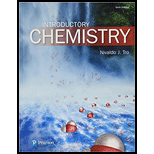
Interpretation: The correct name for each of the given formula is to be identified. In case of incorrect name, the correct name is to be provided.
Concept Introduction: Compound that is composed of a metal and a non-metal is known as an ionic compound.
Acids which are composed of hydrogen and a non-metal are termed as binary acids.
The name of binary acids has the form, base name of the non-metal plus ‘ic-‘prefixed by hydro and suffixed by acid.
Oxyacids are composed of hydrogen, a non-metal, and oxygen.
Oxyacids are acids that contain oxyanions.
If two ions in series are present, ion with more oxygen atoms ends with –ate and ion with fewer oxygen atoms ends with –ite.
If more than two ions in the series are present, use the prefixes hypo- which means ‘less than’ and per- which means ‘more than’.
The name of acids containing oxyanions ending with –ite is named by base name of the oxyanion plus –ous suffixed by acid.
The name of acids containing oxyanions ending with –ate is named by base name of the oxyanion plus –ic suffixed by acid.
Polyatomic ions are comprise of groups of atoms that have an overall charge.
In order to name the ionic compounds that contain the polyatomic anion, name of the cation should be written first, followed by the name of the polyatomic anion.
Want to see the full answer?
Check out a sample textbook solution
Chapter 5 Solutions
INTRODUCTORY CHEMISTRY-W/SEL.SOLN.MAN.
- You have a pure sample of the antiseptic aminacrine, C13H10N2. Calculate the mass in grams of 0.06500 mol aminacrine. Calculate the number of aminacrine molecules in a 0.2480-g sample. Calculate the number of nitrogen atoms in this 0.2480-g sample. Calculate the mass of N in 100. g aminacrine.arrow_forwardA compound associated with the odor of garlic on a persons breath has the chemical formula CyH8S and a formula mass of 88.19 amu. What number does y stand for in the chemical formula of the compound?arrow_forwardArrange the following substances in order of increasing mass percent of nitrogen. a. NO b. N2O c. NH3 d. SNHarrow_forward
- Using the average atomic masses given inside the front cover of this book, calculate the number of atoms present in each of the following samples. l type='a'> 1.50 g of silver, Ag 0.0015 moIe of copper, Cu 0.0015 g of copper, Cu 2.00 kg of magnesium, Mg 2.34 oz of calcium, Ca 2.34 g of calcium, Ca 2.34 moles of calcium, Caarrow_forwardAtomic masses are relative masses. What does this mean?arrow_forwardFor each of the following samples of ionic substances, calculate the number of moles and mass of the positive ions present in each sample. l type="a"> 4.25 g of ammonium iodide, NH4I i>6.31 moles of ammonium sulfide, ( NH4)2S i>9.71 g of barium phosphide, Ba3P2 i>7.63 moles of calcium phosphate, Ca3( PO4)2arrow_forward
- In chemistry, what is meant by the term mole? What is the importance of the mole concept?arrow_forward1. Which of the following hydrocarbons has the highest mass percentage of carbon? methane, CH4 ethane, C2H6 propane, C3H8 butane, C4H10arrow_forward2.37 Why are empirical formulas preferred for describing polymer molecules?arrow_forward
 Chemistry: The Molecular ScienceChemistryISBN:9781285199047Author:John W. Moore, Conrad L. StanitskiPublisher:Cengage Learning
Chemistry: The Molecular ScienceChemistryISBN:9781285199047Author:John W. Moore, Conrad L. StanitskiPublisher:Cengage Learning Introductory Chemistry: A FoundationChemistryISBN:9781337399425Author:Steven S. Zumdahl, Donald J. DeCostePublisher:Cengage Learning
Introductory Chemistry: A FoundationChemistryISBN:9781337399425Author:Steven S. Zumdahl, Donald J. DeCostePublisher:Cengage Learning World of Chemistry, 3rd editionChemistryISBN:9781133109655Author:Steven S. Zumdahl, Susan L. Zumdahl, Donald J. DeCostePublisher:Brooks / Cole / Cengage Learning
World of Chemistry, 3rd editionChemistryISBN:9781133109655Author:Steven S. Zumdahl, Susan L. Zumdahl, Donald J. DeCostePublisher:Brooks / Cole / Cengage Learning
 ChemistryChemistryISBN:9781305957404Author:Steven S. Zumdahl, Susan A. Zumdahl, Donald J. DeCostePublisher:Cengage Learning
ChemistryChemistryISBN:9781305957404Author:Steven S. Zumdahl, Susan A. Zumdahl, Donald J. DeCostePublisher:Cengage Learning Chemistry: An Atoms First ApproachChemistryISBN:9781305079243Author:Steven S. Zumdahl, Susan A. ZumdahlPublisher:Cengage Learning
Chemistry: An Atoms First ApproachChemistryISBN:9781305079243Author:Steven S. Zumdahl, Susan A. ZumdahlPublisher:Cengage Learning





